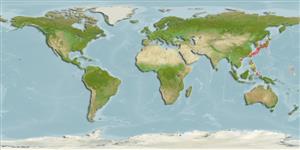>
Anguilliformes (Eels and morays) >
Congridae (Conger and garden eels) > Congrinae
Etymology: Gnathophis: Greek, gnathos = jaw + Greek, ophis = serpent (Ref. 45335).
More on author: Bleeker.
Environment: milieu / climate zone / depth range / distribution range
Ecología
marino bentopelágico; rango de profundidad 183 - 199 m (Ref. 54804). Temperate
Western Pacific: SW part of the Japanese Archipelago, South China seas, including the Philippines.
Tamaño / Peso / Age
Maturity: Lm ? range ? - ? cm
Max length : 41.5 cm TL macho / no sexado; (Ref. 54804)
Short description
Claves de identificación | Morfología | Morfometría
Radios blandos dorsales (total) : 181 - 191; Radios blandos anales: 128 - 132; Vértebra: 121 - 131. Diagnosis: Unpaired fins with dark margins. Second lateral line pore and pores above the pectoral fin from 7th-8th to 11th-15th elevated. Vertebrae 121-131; trunk vertebrae 38-40. Lateral line pores to anus 30-33. Supraorbital canal 6; suborbital canal 8; preoperculomandibular canal 10; occipital commissure 3. Swim bladder reaches slightly behind the anus; stomach dark, while intestine and peritoneum are dark (Ref. 54804).
Life cycle and mating behavior
Maturities | Reproducción | Spawnings | Egg(s) | Fecundities | Larva
Karmovskaya, E.S., 2004. Benthopelagic bathyal conger eels of families Congridae and Nettastomatidae from the Western Tropical Pacific, with descriptions of ten new species. J. Ichthyol. 44(1):S1-S32. (Ref. 54804)
IUCN Red List Status (Ref. 130435)
Threat to humans
Harmless
Human uses
Herramientas
Special reports
Download XML
Fuentes de Internet
Estimates based on models
Preferred temperature (Ref.
123201): 14.1 - 15.4, mean 15.2 °C (based on 4 cells).
Phylogenetic diversity index (Ref.
82804): PD
50 = 0.5000 [Uniqueness, from 0.5 = low to 2.0 = high].
Bayesian length-weight: a=0.00062 (0.00028 - 0.00136), b=3.19 (3.00 - 3.38), in cm total length, based on LWR estimates for this (Sub)family-body shape (Ref.
93245).
Nivel trófico (Ref.
69278): 3.9 ±0.6 se; based on size and trophs of closest relatives
Resiliencia (Ref.
120179): Medio, población duplicada en un tiempo mínimo de 1.4-4.4 años (Preliminary K or Fecundity.).
Fishing Vulnerability (Ref.
59153): Low to moderate vulnerability (32 of 100).
